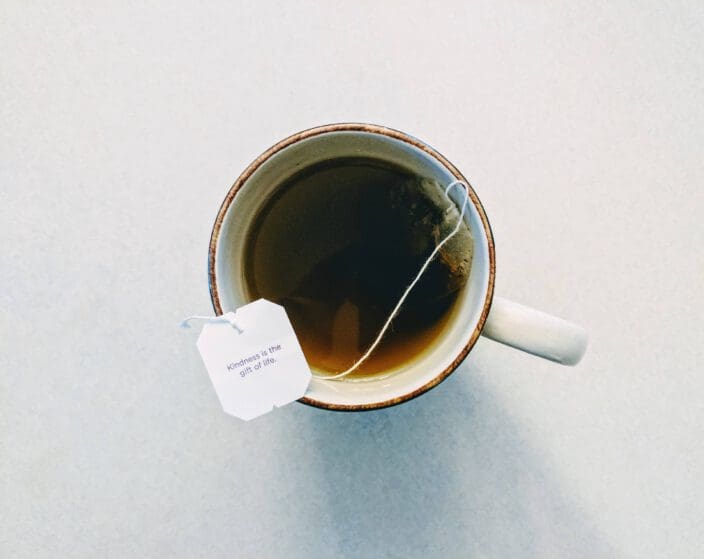Do Tea Bags for Eyes Actually Work (Puffy Eyes & Other)
Home / Vision Education Center /
Last Updated:
The act of placing tea bags on the eyes to relieve inflammation or irritation has been around for a long time, and it represents a valid practice in some cases. Using tea bags for eyes infections as a medicinal practice is easy.
Placing tea bags externally over the eyes may treat a variety of conditions, including inflamed, swollen, or puffy eyes; dark circles under your eyes; redness in the eyes; black eyes; dry eyes; pink eye; and rosacea.
Make sure you see a physician if the problem persists or is severe. Always take precautions when using tea bags on your eyes.
Table of Contents
Are There Benefits to Using Tea Bags on Your Eyes?
A home remedy for treating minor concerns regarding redness or irritation, inflammation (or swollen eyes), or red eyes is to place tea bags on the eyes. This is an affordable self-treatment you can use at home.
This treatment can reduce discomfort associated with some minor issues. It is not a substitute for prompt medical treatment for serious issues or even minor infections, but tea bags for eyes infections has been found to be beneficial in some cases.
You deserve clear vision. We can help.
With 135+ locations and over 2.5 million procedures performed, our board-certified eye surgeons deliver results you can trust.
Your journey to better vision starts here.
How to Use Tea Bags on the Eyes

This is simple to do.
Steep two or more tea bags in the same manner as if you were going to prepare tea to drink. Remove the tea bags from the water, squeeze the liquid out, and then allow the tea bags to cool a bit until they are just warm. You could put them in the refrigerator for a few minutes to cool them down more quickly.
Apply the tea bags to your closed eyes for 10 to 25 minutes. You can also gently massage the area around your eyes if you wish.
Inflamed, Swollen, or Puffy Eyes
Black tea and green tea contain flavonoids and tannins, which have antioxidant effects and are anti-inflammatory. The caffeine in the teas may also constrict the blood vessels in the tissue around your eyes and reduce inflammation.
Green tea may be slightly better than black tea to reduce swollen and inflamed eyes, but either will work.
You can use the tea bags as a warm or cold compress to treat swelling under the eyes as well. For inflammation, using cooler or even cold tea bags may work better.
Some of the other teas that might be effective in reducing inflammation include:
- Chamomile tea.
- Eyebright tea.
- Rooibos tea, which may also make the skin more taunt and reduce wrinkles.
Tea Bags for Dark Circles Under the Eyes
Because the caffeine in tea may help to constrict blood vessels, using cold tea bags may help to reduce the appearance of dark circles under your eyes.
Apply cold green or black tea bags under the eyes.
Tea Bags for Red Eyes
It appears that green tea, chamomile tea, and rooibos teas are popular tea bags to reduce redness and discomfort in the eyes. Most of the evidence is anecdotal, but the anti-inflammatory properties of these products may reduce irritation and inflammation.
Better Than Steak?
Putting a raw steak on a black eye has no effect in reducing the swelling or discomfort associated with the bruise. It might be cheaper and more effective to try tea bags.
The anti-inflammatory effects of green or black tea bags may reduce swelling and bruising associated with a black eye. Other tea bags that may also be soothing for a black eye include chamomile tea and lavender tea.
Dryness in the Eyes
The use of warm tea bags may soothe dry eyes and relieve any irritation. They may also help the eyes retain moisture.
The best tea bags for this purpose would most likely be black tea, eyebright tea, or lavender tea.
Conjunctivitis
Conjunctivitis or pink eye is a highly contagious eye infection that should be treated by a physician.
There is anecdotal evidence that the use of tea bags may relieve some of the symptoms, particularly inflammation and irritation. You can try using chamomile, fennel, or calendula tea bags in addition to black or green tea bags.
Rosacea
Rosacea is a chronic skin condition that typically affects the skin on your face. People with rosacea often have bumpy or pimply raised areas on their face, redness, veins showing through the skin, and irritation of the skin around their face.
The use of tea bags may alleviate some of the symptoms associated with rosacea and soothe the skin. Tea bags may also reduce the associated redness and irritation.
There is some research to suggest that lavender tea and green tea can reduce some of the inflammation and irritation associated with rosacea.
You deserve clear vision. We can help.
With 135+ locations and over 2.5 million procedures performed, our board-certified eye surgeons deliver results you can trust.
Your journey to better vision starts here.
Healing Plants: Camellia Sinensis and Camellia Sinensis Assamica
Camellia sinensis and Camellia sinensis assamica are two strains of the evergreen herb used to produce various tea, including green tea, white tea, dark tea, oolong and yellow tea. These teas are processed differently to produce varying oxidation levels.
A large body of research indicates that in general, tea exhibits properties and has compounds that benefit the entire body, including your eyes. Benefits for eye health attributed to these plants include:
- A high antioxidant count
- Reduced inflammation
- Help for dry eye
They are High in Antioxidants
Antioxidants are essential for optimum health, including that of your eye. Free radicals produced through oxidative stress can damage vulnerable tissue in your eyes. This can worsen or trigger several conditions.
Green, black and white teas are rich in antioxidants such as lutein, vitamin C, vitamin E and zeaxanthin. Antioxidants counteract free radicals’ destructive effects, reducing the risk of many eye diseases such as glaucoma, macular degeneration, and retinal nerve disorder.
Tea Helps Reduce Inflammation

Camellia sinensis is rich in tea polyphenols. Green tea also contains high amounts of flavonoids (catechin). These compounds have been found to have positive effects on inflammation as well as oxidation.
Green tea is more effective against inflammation than black tea due to its higher catechin content. Reduction in inflammation is essential for relieving some symptoms of eye infections, reducing dark circles under your eyes, shrinking eye bags, and soothing sore or red eyes.
Green Tea Can Help with Dry Eye
Dry eye is a common condition, especially for individuals older than 40. Research indicates that green tea extract alleviates inflammatory changes and clinical symptoms of evaporative dry eyes. It also improves ocular surface inflammation.
Best Tea Treatments
You can treat eye conditions using several types of teas. Note that, given an option, you should opt for organic tea. Commercial teas can contain chemical additives.
Green, black and white teas are some of the best options for eye treatments. Other teas that have antioxidative and anti-inflammatory properties beneficial for your eyes include:
- Rooibos tea
- Chamomile tea
- Clary sage (eyebright tea)
- Calendula tea
- Fennel tea
- Oolong tea
- Comfrey tea
- Fenugreek tea
When to See a Doctor

While placing warm or cold tea bags around your eyes may reduce inflammation, irritation, dryness, and other minor symptoms, these home remedies are not designed to cure serious issues like infections. If you have significant eye pain, swelling, irritation, problems with your vision, or other symptoms, you should see a physician.
Do not get fooled by some sources that claim that alternative treatments, like placing tea bags on the eyes, can cure an eye infection or some other major problem. Even in cases where your symptoms are mild, if they persist for more than a few days, you should contact a doctor. If you are in doubt about some situation, discuss the issue with a physician.
Take Precautions Using Tea Bags
Although placing tea bags on your eyes may reduce irritation, inflammation, and pain, you could be making your situation worse if you do not follow a few simple commonsense procedures when placing tea bags on or around your eyes.
- Wash your face and hands thoroughly before you begin treating your eyes with tea bags.
- Take off any makeup before placing tea bags around your eyes.
- Remove your contacts before placing tea bags around your eyes. A major source of eye infections is related to unsanitary use of contact lenses.
- Do not rub or touch your eyes with the tea bags on them.
- Make sure the tea bags are not scalding hot. Never place hot tea bags around your eyes.
- Do not let any of the liquid from the tea bags go into your eyes.
- Do not use tea bags that have staples in them, or at least remove the staples before using them.
- Use unbleached tea bags.
- If you experience any irritation or pain, remove the tea bags immediately.
You deserve clear vision. We can help.
With 135+ locations and over 2.5 million procedures performed, our board-certified eye surgeons deliver results you can trust.
Your journey to better vision starts here.
References
- Evaluation of Anti-Inflammatory Effects of Green Tea and Black Tea: A Comparative In Vitro Study. (April 2012). Journal of Advanced Pharmaceutical Technology and Research.
- Evaluation of Caffeine Gels on Physicochemical Characteristics and In Vivo Efficacy in Reducing Puffy Eyes. (April 2011). Journal of Applied Pharmaceutical Science.
- Clinical Efficacy Comparison of Anti-Wrinkle Cosmetics Containing Herbal Flavonoids. (March 2010). International Journal of Cosmetic Science.
- Antioxidant, Analgesic and Anti-Inflammatory Effects of Lavender Essential Oil. (August 2015). Anais da Academia Brasileira de Ciências.
- Green Tea in Dermatology–Myths and Facts. (August 2015). JDDG: Journal der Deutschen Dermatologischen Gesellschaft.
- Frequency of diagnosis of glaucoma in individuals who consume coffee, tea and/or soft drinks. (July 2018). British Journal of Ophthalmology.
- Camellia sinensis. Integrated Taxonomic Information System (ITIS standard report). Date fetched: September 16, 2021.
- Antioxidant mechanism of tea polyphenols and its impact on health benefits. (June 2020). Animal Nutrition.
- Green tea extract efficacy for dry eye treatment. (February 2017). Journal of Clinical and Diagnostic Research.
- Evaluation of anti-inflammatory effects of green and black tea: A comparative in vitro study. (April-June 2012). Journal of Advanced Pharmaceutical Technology & Research.
This content is for informational purposes only. It may have been reviewed by a licensed physician, but is not intended to serve as a substitute for professional medical advice. Always consult your healthcare provider with any health concerns. For more, read our Privacy Policy and Editorial Policy.
